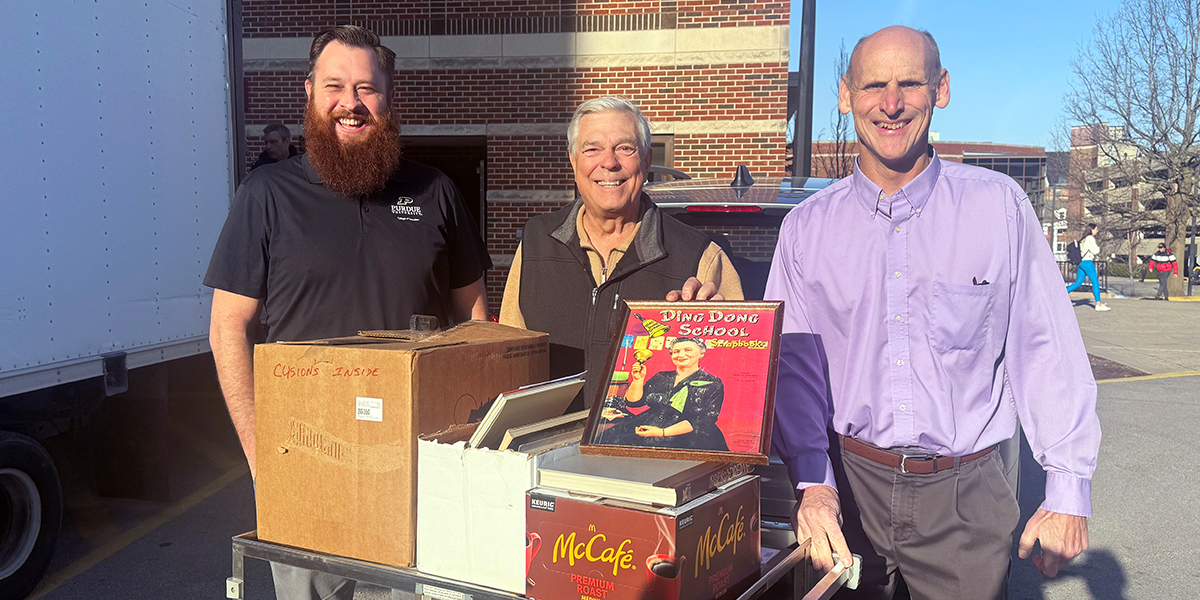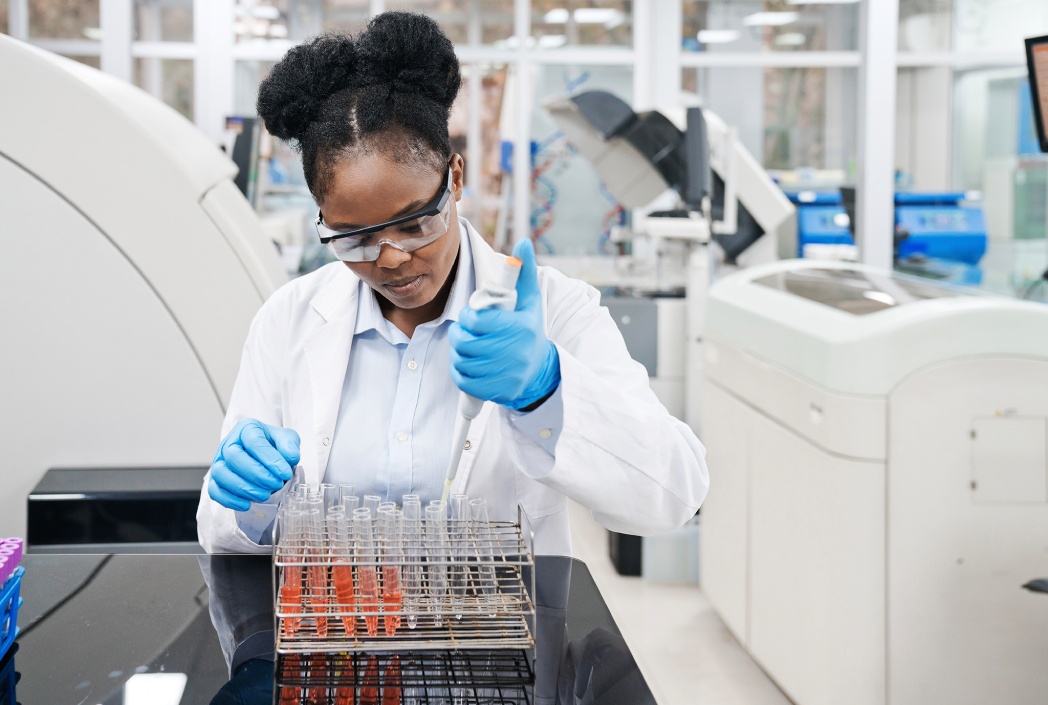AARG-1S: Replicating Martian Life at the SAM Habitat
In February 2025, AARG members had the incredible opportunity to participate in a simulated Mars mission called AARG-1S.

The AARG-1S Blue Team poses in the Test Module (TM) greenhouse of the SAM at the Biosphere 2 habitat with EVA suit and helmet. The Blue Team’s motto was “Vestigia Prima,” which refers to the first footprints on Mars. Image courtesy of Luis Gonzalez.
By Luis Gonzalez
Master’s Student, Space Studies
and Clarke Ferrara
Bachelor’s Student, Space Studies
and Yuki Nishimura
Bachelor’s Student, Space Studies
and William Wallace
Alumnus, Space Studies
In February 2025, the American Public University System Analog Research Group (AARG) ARG-1S team had the incredible opportunity to participate in a simulated Mars mission. This research trip took place at the Space Analog for the Moon and Mars (SAM) at the Biosphere 2 habitat in Oracle, Arizona.
As part of an analog astronaut crew, we lived in a sealed habitat, facing the same challenges that future Mars explorers will encounter:
- Limited resources
- Isolation
- The need for self-sufficiency
During our time at SAM at Biosphere 2, we conducted eight key experiments that explored how humans can survive and thrive on Mars.
Hydroponics: Growing Food in Our Simulated Martian Habitat During the AARG-1S Mission
One of the biggest challenges for long-duration space missions is food production. During the AARG-1S mission, we grew lettuce and herbs hydroponically, monitoring their acidity (pH) and electrical conductivity (EC) levels twice a day.
We inspected the plants for signs of stress, disease and nutrient deficiencies. We also adjusted their environment by adding acid and nutrients to maintain an optimal range.
The most rewarding part? During our mission, we were able to consume the food we grew. It was a small but significant step toward sustainable space farming.
There’s nothing like having live leafy greens in such an isolated habitat sealed off from the world. They contribute to the overall well-being of the crew by improving air quality, boosting morale and creating a sense of connection to nature in an otherwise sterile environment. Their presence serves as a reminder of Earth’s ecosystems and the importance of sustainable life support systems for future space missions.” – Mission Specialist Yuki Nishimura
Electrolysis: Extracting Oxygen for Breathing
Studying electrolysis for Martian and lunar applications is crucial for sustaining future space missions by enabling in-situ resource utilization (ISRU). Reduced-gravity environments, such as on the Moon and Mars, impact electrolysis efficiency by altering gas bubble behavior within a habitat, potentially lowering oxygen production and increasing power demands.
Research on bubble dynamics will help to refine electrolysis models and reduce our reliance on costly parabolic flights for testing the effects of microgravity on gases. Additionally, electrolysis-produced hydrogen can serve as a renewable energy source for long-duration missions, while by-product oxygen has industrial applications that improve the energy efficiency of a space habitat and provide life-giving support for humans in space.

We used a Hoffman apparatus (also known as a Hoffman voltameter) to separate oxygen from water through electrolysis. By adding sodium hydroxide (NaOH) to the water, we increased its conductivity and tested how different current levels affect oxygen production. This experiment is crucial for future life support systems as astronauts will need a reliable way to generate breathable air.
The electrolysis experiment spanned five days, initially using graphite electrodes before transitioning to platinum electrodes. Early trials at six volts yielded minimal gas production. We then increased the voltage to eight volts and later 12 volts, which improved the hydrogen and oxygen yields.
Graphite electrodes performed better at higher voltages, with the final graphite trial at 12 volts producing 6.6 milliliters of hydrogen and 4.4 milliliters of oxygen. Platinum electrodes, introduced on Day 3 of the experiment, initially showed slow gas generation at six volts. However, the output improved at eight volts and 12 volts, with the highest yield being six milliliters of hydrogen and three milliliters of oxygen.
An accidental spill on Day 4 interrupted one trial, but the final tests confirmed that increasing voltage enhanced electrolysis efficiency, particularly with platinum electrodes. Overall, the experiment was successful at producing oxygen in a space analog habitat and shows promise for scalability.
Sodium hydroxide is slippier than you would think!” – Blue Team Mission Commander Luis Gonzalez
Spirulina Algae Growth: A Dual-Purpose Resource

Hawaiian Spirulina®, a nutrient-rich algae, has the potential to provide nutritional assistance for plant growth or food for astronauts while also processing water and producing oxygen from carbon dioxide. We studied its growth under different conditions:
- Shaker beds for controlled movement
- Biobags with an oxygen-rich environment as a viable space storage method
- Clinostats, which simulate microgravity

By monitoring the algae’s growth rates and health, we gained knowledge about how spirulina could supplement astronaut diets while also assisting in greywater purification – a vital system for long-duration space missions. With this experiment, the question of “How will humans eat on Mars?” becomes one step closer and a bit clearer.
Plant-Based Food Study: How Diet Affects Energy Levels
Since meat will be unavailable on Mars, astronauts must rely on a plant-based diet. We conducted a before-and-after study, assessing our energy levels at the start and end of the mission.
Surveys collected from crew members provided a view of how a meat-free diet inside a confined habitat affected our energy, mood, and overall well-being. This research is key in designing nutrition plans for space missions.
As Mission Specialist Aedanaya Diamond and 7i ILMAH Crew Commander says, “Adjusting to a fully plant-based diet isn’t just about nutrition – food plays a key role in crew morale and mission success. Since future space missions will rely on plant-based diets for logistics and sustainability, understanding how astronauts adapt to this shift both psychologically and physiologically is important.
“By exploring the reactions of the crew to this dietary change, we can better design meal systems that not only meet nutritional needs. We can also foster a sense of satisfaction and support long-term well-being during extended missions.”
Bricks Study: Testing Borax for Microbial Control
A challenge in long-term space habitats will be microbial growth on surfaces, which can affect both crew health and biocontamination control. To explore a potential solution, we tested the bacteriostatic properties of Borax® (sodium tetraborate) on simulated Martian regolith bricks.

The experiment had two parts: one conducted inside the habitat and the other by crew members serving as Mission Control outside the habitat. We exposed some of the regolith bricks to the environment in a well-trafficked area for several days, allowing microbial buildup.
We also seeded other bricks outside the Biosphere 2 habitat with bacteria. Then, we applied a Borax solution to the regolith bricks to assess its ability to inhibit bacterial growth and later analyzed the bricks for signs of microbial activity.
Preventing microbial growth in a space habitat is about crew health and long-term habitability. By doing this study, we’re exploring a potential low-maintenance solution for microbial control in any future space or planetary structure.” – Mission Specialist Aedanaya Diamond
Understanding how Borax affects microbial activity in a Martian-like setting could help to inform future habitat construction and maintenance strategies. If effective, this method could provide a simple, low-maintenance way to keep living spaces clean and safe on Mars.
This research highlights the importance of developing passive microbial control methods that require minimal crew intervention, which could significantly improve long-term habitability and maintenance efficiency in future Mars habitats.” – Mission Specialist Clarke Ferrara
Communication Study: Managing the Mars-Earth Delay
Red Team Crew Commander Laura Reiske notes, “The AARG-1S mission to the SAM research facility at Biosphere 2 was particularly exciting to me as it provided a unique opportunity for this communications study. The SAM at Biosphere 2 facilities now include a Mission Control Center (MCC) within their operations building which allows for 24/7 monitoring of their email system used for communications with the crew, as well as the ability to monitor the SIMOC live data coming from the habitat.
“This mission was unique in having two crews who swapped halfway through the mission so that both teams experienced time as MCC and time as crew. The Red Team monitored Mission Control operations during the first five days while the Blue Team was living and working in the habitat. Then, the Blue team took over Mission Control operations and the Red Team moved into the habitat for the last five days.
“This gave us the unique opportunity to investigate if having previous experience in the habitat as a crew member leads to more effective communication between the crew and mission support and in turn experiencing less stress and frustration. I can’t wait to really dig into the data we collected on this mission.”
EVA Locomotion Study: Walking in Different Gravities
Understanding how different gravity conditions impact astronauts’ mobility and cardiorespiratory systems is crucial for future space missions. We studied the effects of bipedal “walking” locomotion in different gravities on astronauts’ heart rates and their performances.
Our research in Martian gravity (0.38 times Earth’s gravity), Earth gravity, and Lunar gravity (0.17 times Earth’s gravity) helps provide valuable data for optimizing astronaut performance and enhancing extravehicular activity (EVA) efficiency. This research will help future missions by improving astronaut mobility, thereby extending EVA durations and efficiency.
Red Team Mission Specialist Keston Denhalter observes, “The feeling of donning a pressurized spacesuit, depressurizing an airlock and walking out into a Martian setting is like no other. Hearing your breathing in your helmet, as you move around in this inflated suit, in a full Martian simulation is such a surreal experience.
“Once the Gravity Rig is set with your weight and you take your first step, it certainly feels weird! It takes a second to teach your body how to move, but eventually, it adapts and it’s incredible. I can only dream of what it will be like for the first person on Mars!”
Drone Study: An Extra Set of Eyes on Mars

Navigating rocky Martian terrain is difficult, especially in a bulky spacesuit with limited visibility. We tested the feasibility of using drones as an extra set of eyes during extravehicular activities. Our study examined:
- How effectively drones could navigate obstacles in a rugged Martian-like environment
- Whether drones could assist astronauts by providing a bird’s-eye view of their surroundings
This proof-of-concept study helps determine the role of drones in increasing astronaut safety and efficiency on Mars.
“This drone study was such a success because not only did we gather data on how well the drone followed the astronauts using the ‘follow me’ feature, but we also saw limitations and crashes. That provided us with data where the current drone technology isn’t advanced enough for certain EVA scenarios.” – Mission Specialist Yuki Nishimura
Looking Toward the Future
Each of these experiments conducted at the Biosphere 2 habitat contributes to the larger goal of establishing a human presence on Mars. From producing oxygen and growing food to testing mobility and communication strategies, our time at SAM provided valuable data that could shape future space missions.
Participating in this analog mission was an unforgettable experience. It offered a unique glimpse into the challenges and innovations that will define the next era of space exploration.
Borax is a registered trademark of U.S. Borax, Inc.
Hawaiian Spirulina is a registered trademark of the Cyanotech Corporation.
About the Authors
Luis Gonzalez is a seasoned military aviator and instructor pilot with over 11 years of experience leading U.S. Air Force intelligence missions the. He graduated from the United States Air Force Academy with a degree in systems engineering and is currently pursuing a master’s degree in space studies at American Military University. In addition to his operational expertise, he has been an active member of AARG for three years, serving as a Mission Specialist to ILMAH, a diver on PIRATE 1 and the Blue Team Mission Commander at SAM 1.
Clarke Ferrara has a background in healthcare and quality control, specializing in research compliance and data integrity within clinical and pharmaceutical settings. She is currently pursuing a bachelor’s degree in space studies with a concentration in aerospace science at American Public University. An active member of AARG, Clarke recently served as a Mission Specialist for the SAM 1 analog research mission at Biosphere 2, contributing to habitat sustainability studies.
Yuki Nishimura is an Associate Principal Scientist at Mars, Inc., bringing 24 years of experience in research and development. He holds a bachelor’s degree in space studies with a concentration in aerospace science from American Military University. Based in Tacoma, Washington, Yuki is an active member of AARG, having served as a Mission Specialist during the SAM 1 mission and as Crew Commander for the 8i mission at the ILMAH analog facility.
William Wallace, last seen as a mission specialist in ILMAH 6I, is an AMU graduate who received a master’s in space studies with a concentration in aerospace science. He also holds a bachelor’s degree in biology from Oregon State University and three associate degrees in general studies, arts, and space systems operations.
As a Sergeant (E5) in the United States Space Force, he has served as a satellite operator specializing in orbital warfare and now leads as a payload engineer for protected MILSATCOM. His outstanding service earned him selection for a commission, making him a Lieutenant Select.
What's Your Reaction?


























